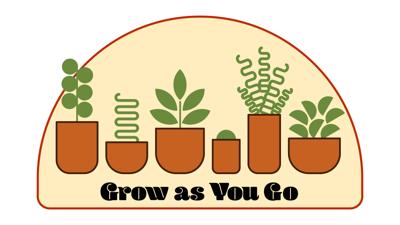
Editor’s note: “Grow As You Go” is a weekly column chronicling the flora of UW and its impact on mental health and overall well-being.
Plants are more like us than we think — they are complex organisms that have immune systems and can react to environmental changes. Two biology labs at UW are studying these reactions and how they can be affected by different environments.
The first lab is led by Adam Steinbrenner, an assistant professor in the department of biology. Steinbrenner studies the immune systems of bean varieties in response to threats from caterpillars. Caterpillars have a molecule called inceptin in their spit; certain beans such as cowpea and the common bean have an inceptin receptor called INR, which triggers the immune response that signals to the plant the arrival of a caterpillar.
“Imagine these individual cells that are fixed in place — that's how plants are structured; [they] have to respond to be able to recognize something that’s potentially an invader,” Steinbrenner said. “Once [these receptors] get activated, it turns on different signaling pathways in the plant that then leads to the synthesis of defense hormones, and those defense hormones then turn on toxins.”
According to Natalia Guayazan Palacios, a third-year doctoral candidate in the department of biology,these responses in the plant can occur in one of two ways: either through a direct response or an indirect response. For example, a direct response would be releasing a molecule that a caterpillar would be unable to digest, eventually killing it. An indirect response would be releasing a molecule that attracts natural predators, such as wasps, to the plant, who would then attack the caterpillars that are threatening it.
Different plants have different responses, and it is important to note that not all bean varieties have this INR. Each type of plant has hundreds of different receptors, each having evolved and changed to suit the plant’s individual needs and to protect it from predators.
Plant immunity and responses are also determined by other things in the environment, such as the circadian rhythm. The circadian rhythm, or circadian clock, is what clues us in to changes in the day, and is affected significantly by light. As humans, we feel the effects of this daily — our hunger and sleep patterns are based in part on the circadian rhythm, but this process significantly affects plants as well.
“We do know that at least against herbivores, plants are better at defending when the herbivores come during the daytime, so when there is light outside,” Guayazan said. “In a sense, or in a way, the plants expect the herbivores to be active during those times, and so they prepare in expectation for that visit.”
On top of knowing when to expect predators, the circadian rhythm also affects other aspects of plants. Takato Imaizumi, a professor in the department of biology, studies how plants know when to flower based on the circadian rhythm and how it affects plant-pollinator reactions.
According to Imaizumi, plants use their circadian clocks to time events throughout the day and to determine the change in seasons or environment. Plants take note of the length of the day and use this information to change their structure to ensure they stay alive and flower at the proper time.
Plants can also use their circadian clock to increase success in pollination, anticipating when pollinators will arrive, as well as coordinating chemical cues so that both the plant and the pollinator can receive maximum benefits. Similar to the legumes in the Steinbrenner lab, these plants can deter predators during the day so that pollinators are able to effectively do their jobs.
Plants are more innovative than we tend to think, and they have evolved over time to suit their individual needs based on their surrounding environment. This innovation allows them to protect themselves and produce crops that we use on a daily basis. We can take notes from this evolution and innovation and use it to improve crop yield and potentially modern medicine. Don’t count plants out just yet.
Reach columnist Taylor Bruce at arts@dailyuw.com. Twitter: @Tay1or_marie9
Like what you’re reading? Support high-quality student journalism by donating here.




(0) comments
Welcome to the discussion.
Log In
Keep it Clean. Please avoid obscene, vulgar, lewd, racist or sexually-oriented language.
PLEASE TURN OFF YOUR CAPS LOCK.
Don't Threaten. Threats of harming another person will not be tolerated.
Be Truthful. Don't knowingly lie about anyone or anything.
Be Nice. No racism, sexism or any sort of -ism that is degrading to another person.
Be Proactive. Use the 'Report' link on each comment to let us know of abusive posts.
Share with Us. We'd love to hear eyewitness accounts, the history behind an article.